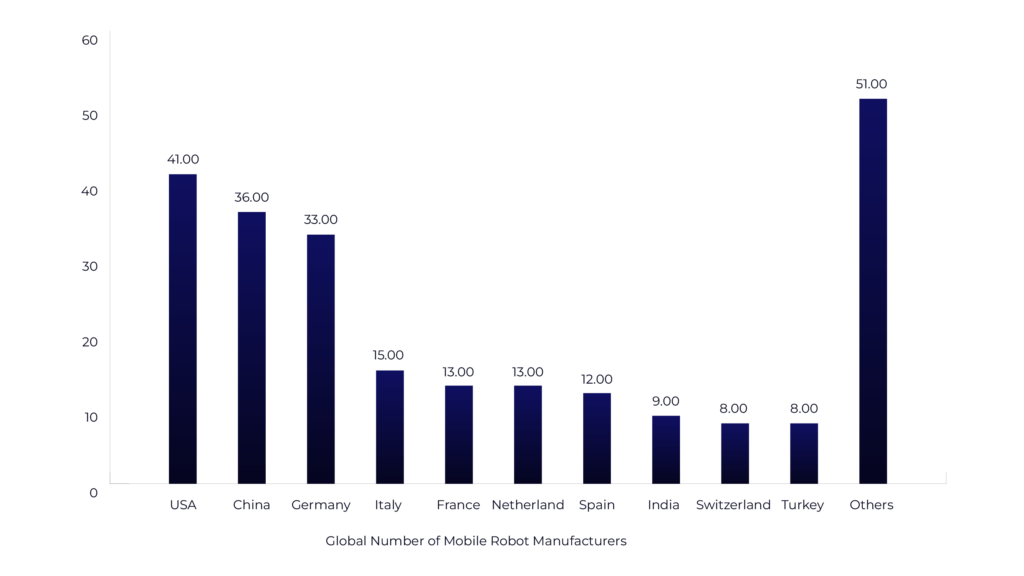Robotics in Healthcare: The Future of Medical Robots
What is Robotics in healthcare?
The employment of robots and automation technology in medical settings to enhance patient care and results is referred to as robotics in healthcare. These robots are capable of a wide range of duties, from straightforward operations like dispensing medication and taking vital signs to intricate processes like surgery and rehabilitation.
Market research has shown that the use of robotics in healthcare provides several advantages. Firstly, robots possess the ability to execute tasks requiring fine motor skills with remarkable accuracy and precision, minimizing the risk of errors. This precision translates into improved patient safety and more effective treatment outcomes. Moreover, robots can contribute to reducing the spread of infections by minimizing human contact in certain healthcare procedures.
Robots are utilised in healthcare in a variety of ways, such as surgical robots that help with minimally invasive procedures, telepresence robots that enable remote medical consultations, and rehabilitation robots that aid patients in recovering from illnesses or injuries.
In general, robots in healthcare are an emerging topic that has the potential to revolutionise how healthcare is provided while also enhancing patient outcomes and cutting costs. Using robots in the medical industry helps increase operational efficiencies while improving patient care and outcomes.
What is Global Market Size of Robotics in Healthcare by 2030?
According to a recent competitor analysis, the acceptance and demand for AI and robotics in healthcare are steadily increasing in Europe, the Middle East, and Africa. As per one of the surveys, people in Europe, the Middle East, and Africa found that more than half (54%) are open to using AI and robotics for healthcare, and that close to half—up to 73%—would even be willing to have minor surgery done by a robot. Robotics will undoubtedly become more prevalent in the healthcare industry in the next few years.

- The market for healthcare service robots was estimated to be worth USD 10.4 million in 2021 and is anticipated to grow to USD 53.4 million by 2030, with a CAGR of 19.33% from 2022 to 2030.
- In 2021, the Asia Pacific region held a revenue share of over 68%, leading the market for healthcare service robots.
- With a revenue share of about 18.9% in 2021, the disinfection robots market was the second-highest revenue holder by product.
- Leading Global Medical robotic manufacturing companies identified are Intuitive Surgical, Medtronic, Cyberdyne, Globus, HollySys, iRobot, Johnson & Johnson, Omron, ReWalk Robotics, and Stryker.
Stay Ahead with KYM Global Insights
Stay informed and ahead of the curve with KYM Global Insights. Gain access to the latest trends, consumer behavior, and technological progress shaping the future of healthcare robotics. Talk to Expert for custom requirement.
Importance of Robots
- Robotics in healthcare has grown in popularity as a result of technological advancements, and both patients and healthcare professionals can benefit greatly from its use.
- High-quality patient care, effective clinical procedures, and a secure working environment for healthcare professionals are all made possible by robotics in the sector.
- One of the primary advantages of incorporating robots in healthcare is the enhancement of patient care. These intelligent machines can perform a range of tasks with precision and consistency, including medication administration, vital sign monitoring, and routine check-ups.
- By assuming these repetitive responsibilities, robots alleviate healthcare professionals from mundane tasks, allowing them to focus on critical aspects of patient care, such as accurate diagnosis and personalized treatment planning. This not only raises the quality of care but also ensures that patients receive timely attention and support, enhancing their overall experience.
Different Types of Medical Robots/Medical Robotics:
Robots created specifically to carry out tasks in the medical industry are referred to as medical robots. These robots can help medical personnel with a variety of activities in several healthcare environments, including hospitals, clinics, and research labs.
Although the phrases medical robots and healthcare robots are frequently used synonymously, there is little distinction between the two.
Health monitoring, companionship, and mobility aid are just a few of the many activities that healthcare robots may do. They are made to help in healthcare environments. Patients can communicate with them and receive assistance from them in maintaining their health and well-being.
Medical robots, on the other hand, are created expressly to carry out medical procedures including surgeries, injections, and diagnostic testing. They are created to collaborate closely with healthcare professionals to enhance patient outcomes and are highly specialised.
Medical robots are focused on carrying out specific medical activities with a high degree of precision and accuracy, as opposed to healthcare robots, which aim to improve patient’s overall health and welfare. Medical robots are highly specialised and made to conduct medical procedures with a high degree of accuracy, whereas healthcare robots have a wider range of skills and are made to help patients in a variety of ways.
Modular Robots
Modular robots can be customised to do a variety of tasks and improve other systems. These include prosthetic robotic arms and legs and therapeutic exoskeleton robots in the field of healthcare.
Therapeutic robots can aid in the recovery process following strokes, paralysis, traumatic brain injuries, or disabilities brought on by multiple sclerosis. To help people with spinal injuries carry out daily duties, Intel and Accenture are now creating a robotic arm that can be put on a wheelchair. Robots using AI and depth cameras can measure a patient’s progress more precisely than a human eye by monitoring the degree of motion in various positions and keeping track of their form as they perform the activities that are recommended.
Autonomous Mobile Robots
Because they may help with essential requirements like telepresence, drug distribution, and disinfection while freeing up workers to spend more time with patients, AMRs are frequently used by healthcare organisations. AMRs can self-navigate to patients in exam or hospital rooms when fitted with light detection and ranging (LiDAR) devices, visual computing, or mapping capabilities, enabling doctors to communicate from a distance. An AMR can accompany doctors as they perform hospital rounds if it is operated by a remote specialist or other employees. This enables the specialist to provide input via an on-screen consultation regarding patient diagnosis and management.
Before a patient is checked in, certain robots can help specialists. One autonomous robot, for instance, exists in Mexico. created by a startup The medical staff uses Roomie to assist with high-risk COVID-19 patients.
Types of Autonomous Mobile Robots that are utilised in the healthcare industry:
Service Robots: Service robots handle regular logistical duties to ease the everyday stress on healthcare professionals. Many of these robots work autonomously and are capable of sending reports after finishing a task. These machines organise patient spaces, keep track of supplies and buy orders, replenish medical supply cabinets, and move linens to and from laundries.
Social Robots: Social robots engage in direct human interaction. These “friendly” robots can provide social interaction and surveillance in long-term care facilities.
Nursing Robots
Even though nurses put in a lot of effort, especially in hospitals with high patient loads, they just are unable to care for every patient. Understaffed teams are receiving assistance from robotic nurses. For example, a venepuncture robot may produce a 3D image of the patient’s arm to show the nurse exactly where the patient’s vein is, making the process much simpler and quicker. Since many people find needles to be unpleasant and even terrifying, this also improves the patient experience.
Sanitation Robots
During and after the COVID-19 epidemic, the significance of cleaning and sanitising care spaces has been noticeably increased. Sanitation procedures must be consistently performed at a high level in today’s healthcare facilities because they are essential to the healing process. Medical robots are suited for duties including sanitation and disinfection.
Exoskeletons
Although exoskeletons may not be the first thing that comes to mind when you hear the word “robot,” they are profoundly changing the way that humans heal. The people most impacted by this are those who are healing from injuries that require considerable physical therapy.
Care Robots
Care robots come in a variety of forms and dimensions. Some are intended to provide physical care, such as lifts that can help elderly individuals stand up when they are unable to do so on their own, exercise and mobility aids, fall detection equipment, feeding apparatuses, and aids for bathing or using the lavatory.
Future Tech: Microbots
Robotics on a much smaller scale is referred to as micro-robotics. It involves tiny robots, referred to as microrobots, which are frequently created for research purposes or particular uses in the biotech industry, like diagnosis and treatment. These tiny robots are typically millimetres or smaller. However, size restrictions are flexible and can differ amongst researchers and use cases. Micro Robotics is the emergence of a game changer in the field of medical and Healthcare industry.

Advantages of Robots in Healthcare Industry
In the rapidly evolving healthcare landscape, robots are emerging as innovative solutions to enhance patient care, operational efficiency, and safety standards. By offering a suite of benefits that range from performing repetitive tasks to assisting in complex surgeries, robots are revolutionizing the healthcare industry. As the healthcare industry experiences dynamic transformations, robots are stepping up as trailblazers. They offer a plethora of advantages, from executing mundane tasks to aiding in sophisticated surgical operations, fundamentally reshaping the healthcare arena.
Superior Efficiency
Robotics, when integrated into healthcare, results in a remarkable surge in efficiency. These mechanical marvels can execute repetitious tasks with unparalleled speed and accuracy, substantially diminishing human errors. Whether it’s handling patient information, distributing medicines, or assisting in complex surgical procedures, robots ensure tasks are completed expeditiously and accurately. In the healthcare world, where every second and accurate execution can mean the difference between life and death, such operational efficiency is crucial.
Financial Prudence
The upfront cost for robotics might be high, but the extensive financial advantages over time are worth considering. Robots are not subject to the constraints of breaks, holidays, or sick leave, and they can operate continuously without the risk of fatigue or decreased output. This decline in operational expenses, paired with increased efficiency and enhanced patient outcomes, positions robots as a financially sound investment for the long haul.
Personalized Precision
Another key advantage of using robotics in healthcare is their ability to be customized. Robots can be programmed to execute a broad range of tasks tailored to patient-specific needs, offering bespoke care. Surgical robots, for example, can be calibrated to match a patient’s unique anatomy for precise incisions and minimal invasiveness. Likewise, therapeutic robots can be customized to align with a patient’s individual rehabilitation requirements, accelerating their recovery.
Remote healthcare
Robots are also instrumental in enabling remote healthcare, an essential requirement in our increasingly interconnected society. Telepresence robots, for instance, enable healthcare professionals to interact with and provide treatment to patients from a distance, eliminating the necessity for in-person visits. This proves particularly advantageous for patients living in far-flung or rural areas, who might otherwise face difficulties in accessing healthcare services.
Lessened Infection Risks
Infection risk is a perpetual concern in healthcare environments. However, robots can execute tasks that require close patient interaction, thereby significantly lowering the risk of infection spread. Robots can sterilize hospital rooms, deal with biohazardous waste, and even aid in surgeries, reducing the exposure of healthcare workers to potentially infectious substances.
Enhanced Safety
By using healthcare robots to carry out hazardous or risky duties like handling harmful chemicals or helping with procedures, the chance of harm to medical staff is reduced.
Robots that are expressly made to help with medical duties, patient care, and other healthcare-related services are known as “healthcare robots.” Here are a few instances of healthcare robots in use:
Healthcare robots have the potential to enhance patient outcomes and boost service productivity. Future healthcare robot applications are likely to be increasingly creative as technology develops.
Discover More about Healthcare Robotics
Dive deeper into the world of healthcare robotics. Learn how this advanced technology is revolutionizing patient care and clinical operations. Talk to Expert for custom requirement.
Why is Robotics Important in the Future?
- Robotics in healthcare has grown in popularity as a result of technological advancements, and both patients and healthcare professionals can benefit greatly from its use.
- High-quality patient care, effective clinical procedures, and a secure working environment for healthcare professionals are all made possible by robotics in the sector.
- For a long time, scientists have been developing “microbots.” These tiny devices can rapidly and easily create repairs as they travel throughout the human body. Instead of severing the patient’s body, microbots would do surgery from within. These robots can be as small as a single human cell, making them considerably less likely than conventional surgical methods to cause tissue damage or other issues. Building such tiny robots that can be controlled precisely is extremely difficult.
- Researchers from all over the world are experimenting with a variety of approaches to the technology. Thanks to medical robots, the healing process is becoming more efficient, safe, and intelligent for both patients and carers.
- By lowering stress and staffing shortages, medical robots benefit nurses and healthcare teams. Primary interviews with experts in the field have shed light on the transformative potential of robotics in healthcare.
- Robotics is an industry that is constantly changing. Medical robots are just getting started, and future discoveries that enable intuitive healing based on cutting-edge technology will further change healthcare.
Conclusion:
The field of healthcare robotics is rapidly advancing, poised to revolutionize patient care, advance clinical operations, and establish safer working conditions for medical professionals. By leveraging robots and automation in healthcare, we can achieve unprecedented levels of precision, boost patient safety, minimize infection risks, and elevate operational efficiency.
As per the latest data from KYM Global Insights, the international market for healthcare robotics is expected to soar to a staggering $53.4 billion by 2030. This impressive growth is fueled by the expanding acceptance and demand for AI and robotics within healthcare sectors across Europe, the Middle East, and Africa. Pioneers like Intuitive Surgical, Medtronic, and Johnson & Johnson are leading the charge in this dynamic market.
As a trusted healthcare market research and consultancy powerhouse, KYM Global Insights delivers crucial understanding of market trends, consumer behavior, and cutting-edge technological progress shaping the future of healthcare robotics. Their expertise empowers stakeholders and healthcare organizations to comprehend market dynamics, spot opportunities, and make educated decisions.
Join the Robotics Revolution
Ready to join the healthcare robotics revolution? Whether you’re a healthcare organization or a stakeholder, this is your chance to make a difference. Talk to Expert for custom requirement.

Nandini is a highly accomplished healthcare industry professional with an impressive track record of success. With 15 years of experience working for major healthcare companies, she brings a wealth of knowledge and expertise to our firm. As our Research Head at KYM Global Insights, Nandini oversees all of our research and consulting services, working closely team of experts to deliver insights that shape the future of healthcare. Whether conducting in-depth market analysis, developing custom research methodologies, or providing strategic guidance to our clients, she is dedicated to delivering the highest quality services that help clients achieve their goals.
